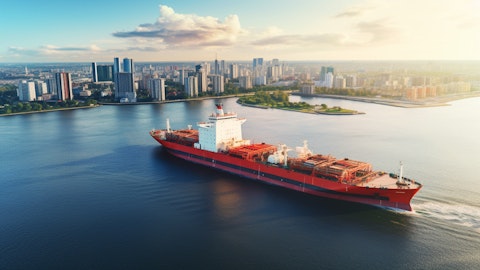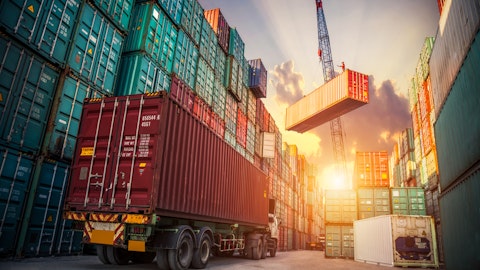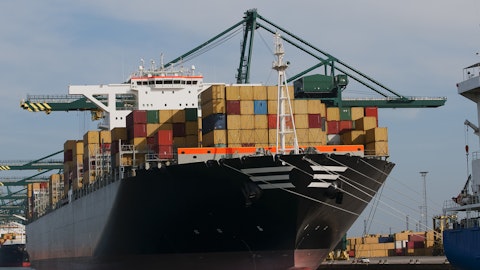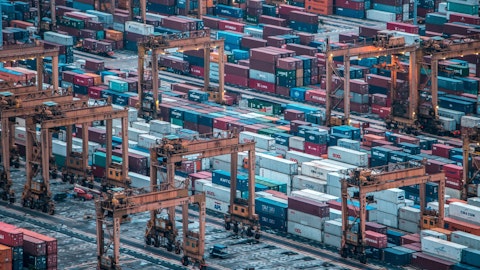David Grzebinski: Absolutely. Yes, absolutely. Oil and gas is still going to cycle. Overall, you’ll see, ’24 versus ’23, we’re seeing that revenue and D&S is going to be down to – flat to slightly down. And that’s really all based on oil and gas. C&I is offsetting it, but you’ve – I’m sure you’ve heard calls on the oilfield side, whether it’s pressure pumpers or E&P or service companies, they’re all looking for a down year, ’24 over ’23. That that’s in our guidance, and that’s why you’re seeing kind of flattish revenue for D&S. Really the strength of C&I is making that look not as bad.
Ben Nolan: Okay. And then for my second question, shifting gears a little bit. The Coastal business looks like it’s finally going to be in for a pretty good year, although I was looking at it, I mean you’re down to, I think, like 28 Coastal barges, I mean there was a point at which you were at 80. I know that has not been obviously a focus of growth for you and you’ve said it, at least in the past, it hasn’t been, but is there a point where you just need sort of critical scale or is there a point at which you maybe think about adding to that or it remains sort of not the primary focus?
David Grzebinski: Yes, well, I mean our preference would be Inland Marine. If we’re going to grow anywhere, it would be in Inland Marine, would be our preference. That said, Coastal’s going to be a great five-year story here. We are – supply and demand are in balance now. We’re – as you saw in our prepared remarks, we saw spot prices up year-over-year in the mid-30% range and term contracts up in the mid-20% – or low-20% range. That’s going to continue in ’25, ’26, probably into ’27 easily. We need it. The rates have been low. We’ve been bouncing along in our Coastal business at breakeven. This year for ’24, we’re going to be kind of mid-single-digits, maybe even get to the high-single-digits in terms of operating income margins, and really, that should continue because of the supply picture.
As you know, these vessels are very expensive. 185,000 barrel unit we built 5 years ago for $80 million, right now if you were to build that, it would be $130 million, $135 million to build it, and nobody’s got one on the books. And even if they did, you wouldn’t get it until 2027. So we’re very enthusiastic about the Coastal business. Does that mean we want to go out and speculatively build? Absolutely not. I mean, we’re – there may be some contracts coming from customers that we would get that, but we’re not going to go. And just to comment on the – on our fleet. Our actual high, I think, was 59 barges, not 80, but we took out a lot of wire barges, wire. The customer demand for wire barges was low, they were older. We’ve got a much higher quality fleet now.
And the other thing, just in terms of construct there, what happened to that business was the ban on exporting crude was lifted. So, one point, we had 17 barges moving crude in the coastwise business, now we got zero, and that happened all across the industry. And that’s why we’ve been in a protracted downturn in that business. And all that excess supply has been retired and it’s in balance now and we’re pretty excited about it, Yes.
Ben Nolan: Okay. And there’s – you don’t think there’s any critical mass issues or economies of scale issues or anything where you are just playing large now?
David Grzebinski: Yes, I – no, I think we’re still one of the largest players in this space. On a barrel volume basis, we’re probably one or two. There is – two of our competitors are trying to get together in a joint venture, so, that we’ll see what that brings, but we’re still one or two in the market in terms of size. So we’ve got the critical mass, and as it’s the same customers that we deal with on the Inland side. So we have that scale, just because our commercial team deals and our bidding team deals with the major customers every day, and it’s the same group, whether it’s Coastal or Inland.
Ben Nolan: Got you. I appreciate it. And lastly, just congratulations to Joe Pyne, it was a heck of a career.
David Grzebinski: Yes, thanks for saying that. I mean, Joe, he’s an institution, he’s basically been the father of our business for 46 years, and grew it from nothing into what it is today. He’ll be missed. Thanks, Ben.
Ben Nolan: Yes.
Operator: Our next question will come from Ken Hoexter of Bank of America. Your line is open.
Ken Hoexter: Hi, good morning, David, Raj. So, just, by the way, first, let me throw it in as well, just long career, long time working with Joe, so best of luck as he moves on. And thanks for all the help over the years. Your Inland barge segment, right, if 4Q exits at 20% and most contracts renew in – or near 20%, sorry, and most contracts renew in the fourth quarter, has pricing stalled at Inland and thus, we’re not seeing acceleration in your margin target from basically fourth quarter run rate levels? I’m just trying to guess maybe where are spot levels now, is it possible to achieve the mid-20s, kind of that you talked about, if pricing keeps accreting it, given your costs, hopefully, have decelerated on inflation basis? Thanks.
David Grzebinski: Yes, and the short answer is, yes, we will definitely get to the mid-20s. But let me give some color, Ken. I think it’s a great question. The average for the fourth quarter was in the high teens. December was an okay weather month, so we touched that 20%. First quarter is always the worst weather, so we’re anticipating margins will dip back down into the high teens in the first quarter because of the weather, by the second and third will be probably north of 20. Fourth quarter, we’ll have to see, that’s always a tough weather months. I – the way I look at margins, Ken, is, look, we will be up year-over-year 300 basis points to 400 basis points in margin. Because of weather, high water, low water, hurricanes, lock closures, it’s just hard to get any one quarters too specific, but my view is that the whole entity will be up 300 basis points to 400 basis points.



